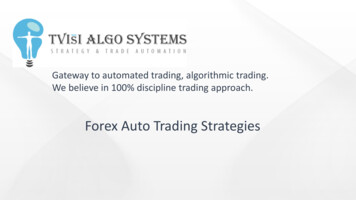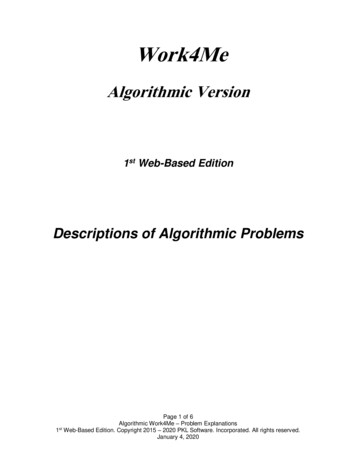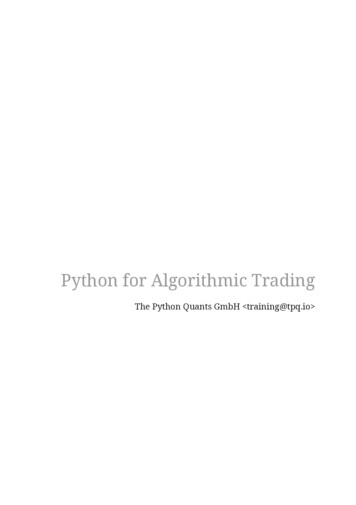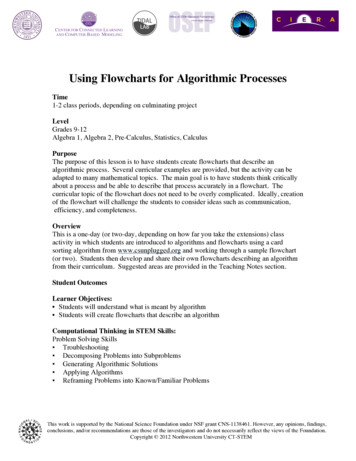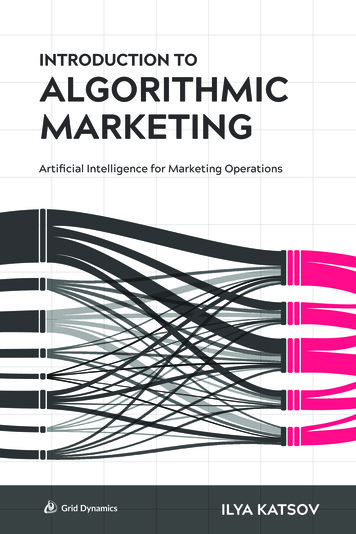
Transcription
I LYA K AT S O VINTRODUCTION TOALGORITHMIC MARKETING
Introduction to Algorithmic Marketingby Ilya KatsovVisit the book’s website at https://algorithmicweb.wordpress.comfor additional resources.ISBN 978-0-692-98904-3Copyright 2018 Ilya KatsovAll rights reserved. The digital version of the book is available fordownload on algorithmicweb.wordpress.com and can be shared onlythrough a link to the landing page. No part of this book may bemodified, reposted, emailed, or made available for download on othersites or channels, without the prior written permission of the author.
v“At a time when power is shifting to consumers, while brands and retailersare grasping for fleeting moments of attention, everyone is competing on dataand the ability to leverage it at scale to target, acquire, and retain customers.This book is a manual for doing just that. Both marketing practitioners andtechnology providers will find this book very useful in guiding them throughthe marketing value chain and how to fully digitize it. A comprehensive andindispensable reference for anyone undertaking the transformational journeytowards algorithmic marketing.”—Ali Bouhouch, CTO, Sephora Americas“If you’re tired of the vague fluff about AI in marketing, and you want tounderstand the real substance of what’s possible today and how it works, thenyou must read An Introduction to Algorithmic Marketing. This is the bestbook in the field of marketing technology and operations that I’ve read yet.”—Scott Brinker,Author of Hacking Marketing, Editor of chiefmartec.com“Its all possible now. This book brings practicality to concepts that just afew years ago would have been dismissed as mere theory. It features principledframing that captures what the best marketers innately feel but cannot express.Elegant math articulates the important relationships that are so elusive to traditional business modeling. The book is unapologetic for its lack of spreadsheetexamples – much of the world can not be represented linearly in just a fewdimensions and devoid of uncertainty. Instead, the book embraces rigorousframing that yields better insights into real phenomenon. It’s written neitherfor the data scientist nor the marketer, but rather for the two combined! Itsthis partnership between these two departments that will lead to real impact.This book is where that partnership should begin.”—Eric Colson, Chief Algorithms Officer, Stitch Fix
vi“This book is a live portrait of digital transformation in marketing. It showshow data science becomes an essential part of every marketing activity. Thebook details how data-driven approaches and smart algorithms result in deepautomation of traditionally labor-intensive marketing tasks. Decision-makingis getting not only better but much faster, and this is crucial in our everaccelerating competitive environment. It is a must-read for both data scientistsand marketing officers–even better if they read it together.”—Andrey Sebrant, Director of Strategic Marketing, Yandex“Introduction to Algorithmic Marketing isn’t just about machine learningand economic modeling. It’s ultimately a framework for running business andmarketing operations in the AI economy.”—Kyle McKiou,Sr. Director of Data Science, The Marketing Store“This books delivers a complete end-to-end blueprint on how to fully digitizeyour company’s marketing operations. Starting from a conceptual architecturefor the future of digital marketing, it then delves into detailed analysis of bestpractices in each individual area of marketing operations. The book gives theexecutives, middle managers, and data scientists in your organization a set ofconcrete, actionable, and incremental recommendations on how to build betterinsights and decisions, starting today, one step at a time.”—Victoria Livschitz, founder and CTO, Grid Dynamics
vii“While virtually every business manager today grasps the conceptualimportance of data analytics and machine learning, the challenge of implementing actual competitive solutions rooted in data science remains quitedaunting. The scarcity of data scientist talent, combined with the difficultyof adapting academic models, generic open-source software and algorithmsto industry-specific contexts are among the difficulties confronting digitalmarketers around the world. This book by Ilya Katsov draws from the deepdomain expertise he developed at Grid Dynamics in delivering innovative,yet practical digital marketing solutions to large organizations and helpingthem successfully compete, remain relevant, and adapt in the new age of dataanalytics.”—Eric Benhamou,founder and General Partner, Benhamou Global Ventures;former CEO and Chairman of 3Com and Palm“This book provides a much-needed collection of recipes for marketing practitioners on how to use advanced methods of machine learning and data scienceto understand customer behavior, personalize product offerings, optimize theincentives, and control the engagement – thus creating a new generation ofdata-driven analytic platform for marketing systems.”—Kira Makagon, Chief Innovation Officer, RingCentral;serial entrepreneur, founder of RedAril and Octane
CONTENTS1introduction1.1 The Subject of Algorithmic Marketing . . . . . . . . . . .1.2 The Definition of Algorithmic Marketing . . . . . . . . . .1.3 Historical Backgrounds and Context . . . . . . . . . . . .1.3.1 Online Advertising: Services and Exchanges . . . . .1.3.2 Airlines: Revenue Management . . . . . . . . . . . . .1.3.3 Marketing Science . . . . . . . . . . . . . . . . . . . . .1.4 Programmatic Services . . . . . . . . . . . . . . . . . . . .1.5 Who Should Read This Book? . . . . . . . . . . . . . . . .1.6 Summary . . . . . . . . . . . . . . . . . . . . . . . . . . . .2 review of predictive modeling2.1 Descriptive, Predictive, and Prescriptive Analytics . . . .2.2 Economic Optimization . . . . . . . . . . . . . . . . . . . .2.3 Machine Learning . . . . . . . . . . . . . . . . . . . . . . .2.4 Supervised Learning . . . . . . . . . . . . . . . . . . . . . .2.4.1 Parametric and Nonparametric Models . . . . . . . .2.4.2 Maximum Likelihood Estimation . . . . . . . . . . . .2.4.3 Linear Models . . . . . . . . . . . . . . . . . . . . . . .2.4.3.1 Linear Regression . . . . . . . . . . . . . . . . . .2.4.3.2 Logistic Regression and Binary Classification . .2.4.3.3 Logistic Regression and Multinomial Classification . . . . . . . . . . . . . . . . . . . . . . . . . . .2.4.3.4 Naive Bayes Classifier . . . . . . . . . . . . . . . .2.4.4 Nonlinear Models . . . . . . . . . . . . . . . . . . . . .2.4.4.1 Feature Mapping and Kernel Methods . . . . . .2.4.4.2 Adaptive Basis and Decision Trees . . . . . . . .2.5 Representation Learning . . . . . . . . . . . . . . . . . . .2.5.1 Principal Component Analysis . . . . . . . . . . . . .2.5.1.1 Decorrelation . . . . . . . . . . . . . . . . . . . . .2.5.1.2 Dimensionality Reduction . . . . . . . . . . . . .2.5.2 Clustering . . . . . . . . . . . . . . . . . . . . . . . . .2.6 More Specialized Models . . . . . . . . . . . . . . . . . . .2.6.1 Consumer Choice Theory . . . . . . . . . . . . . . . .2.6.1.1 Multinomial Logit Model . . . . . . . . . . . . . .2.6.1.2 Estimation of the Multinomial Logit Model . . .2.6.2 Survival Analysis . . . . . . . . . . . . . . . . . . . . .2.6.2.1 Survival Function . . . . . . . . . . . . . . . . . .2.6.2.2 Hazard Function . . . . . . . . . . . . . . . . . . .2.6.2.3 Survival Analysis Regression . . . . . . . . . . . 246495252545758606264ix
xcontents2.6.3 Auction Theory . . . . . . . . . . . . . . . .2.7 Summary . . . . . . . . . . . . . . . . . . . . . .3 promotions and advertisements3.1 Environment . . . . . . . . . . . . . . . . . . . .3.2 Business Objectives . . . . . . . . . . . . . . . .3.2.1 Manufacturers and Retailers . . . . . . . . .3.2.2 Costs . . . . . . . . . . . . . . . . . . . . . .3.2.3 Gains . . . . . . . . . . . . . . . . . . . . . .3.3 Targeting Pipeline . . . . . . . . . . . . . . . . .3.4 Response Modeling and Measurement . . . . .3.4.1 Response Modeling Framework . . . . . . .3.4.2 Response Measurement . . . . . . . . . . .3.5 Building Blocks: Targeting and LTV Models . .3.5.1 Data Collection . . . . . . . . . . . . . . . .3.5.2 Tiered Modeling . . . . . . . . . . . . . . . .3.5.3 RFM Modeling . . . . . . . . . . . . . . . .3.5.4 Propensity Modeling . . . . . . . . . . . . .3.5.4.1 Look-alike Modeling . . . . . . . . . .3.5.4.2 Response and Uplift Modeling . . . . .3.5.5 Segmentation and Persona-based Modeling3.5.6 Targeting by using Survival Analysis . . . .3.5.7 Lifetime Value Modeling . . . . . . . . . . .3.5.7.1 Descriptive Analysis . . . . . . . . . . .3.5.7.2 Markov Chain Models . . . . . . . . . .3.5.7.3 Regression Models . . . . . . . . . . . .3.6 Designing and Running Campaigns . . . . . . .3.6.1 Customer Journeys . . . . . . . . . . . . . .3.6.2 Product Promotion Campaigns . . . . . . .3.6.2.1 Targeting Process . . . . . . . . . . . .3.6.2.2 Budgeting and Capping . . . . . . . . .3.6.3 Multistage Promotion Campaigns . . . . .3.6.4 Retention Campaigns . . . . . . . . . . . . .3.6.5 Replenishment Campaigns . . . . . . . . .3.7 Resource Allocation . . . . . . . . . . . . . . . .3.7.1 Allocation by Channel . . . . . . . . . . . .3.7.2 Allocation by Objective . . . . . . . . . . . .3.8 Online Advertisements . . . . . . . . . . . . . .3.8.1 Environment . . . . . . . . . . . . . . . . . .3.8.2 Objectives and Attribution . . . . . . . . . .3.8.3 Targeting for the CPA-LT Model . . . . . .3.8.3.1 Brand Proximity . . . . . . . . . . . . .3.8.3.2 Ad Response Modeling . . . . . . . . .3.8.3.3 Inventory Quality and Bidding . . . . . . . . . . . . . 6149151152152
contents3.8.4 Multi-Touch Attribution . . . . . . . .3.9 Measuring the Effectiveness . . . . . . . .3.9.1 Randomized Experiments . . . . . . .3.9.1.1 Conversion Rate . . . . . . . . . .3.9.1.2 Uplift . . . . . . . . . . . . . . . .3.9.2 Observational Studies . . . . . . . . .3.9.2.1 Model Specification . . . . . . . .3.9.2.2 Simulation . . . . . . . . . . . . .3.10 Architecture of Targeting Systems . . . . .3.10.1 Targeting Server . . . . . . . . . . . . .3.10.2 Data Management Platform . . . . . .3.10.3 Analytics Platform . . . . . . . . . . .3.11 Summary . . . . . . . . . . . . . . . . . . .4 search4.1 Environment . . . . . . . . . . . . . . . . .4.2 Business Objectives . . . . . . . . . . . . .4.2.1 Relevance Metrics . . . . . . . . . . . .4.2.2 Merchandising Controls . . . . . . . .4.2.3 Service Quality Metrics . . . . . . . . .4.3 Building Blocks: Matching and Ranking .4.3.1 Token Matching . . . . . . . . . . . . .4.3.2 Boolean Search and Phrase Search . .4.3.3 Normalization and Stemming . . . . .4.3.4 Ranking and the Vector Space Model4.3.5 TF IDF Scoring Model . . . . . . . . .4.3.6 Scoring with n-grams . . . . . . . . . .4.4 Mixing Relevance Signals . . . . . . . . . .4.4.1 Searching Multiple Fields . . . . . . .4.4.2 Signal Engineering and Equalization .4.4.2.1 One Strong Signal . . . . . . . . .4.4.2.2 Strong Average Signal . . . . . . .4.4.2.3 Fragmented Features and Signals4.4.3 Designing a Signal Mixing Pipeline .4.5 Semantic Analysis . . . . . . . . . . . . . .4.5.1 Synonyms and Hierarchies . . . . . .4.5.2 Word Embedding . . . . . . . . . . . .4.5.3 Latent Semantic Analysis . . . . . . .4.5.4 Probabilistic Topic Modeling . . . . .4.5.5 Probabilistic Latent Semantic Analysis4.5.5.1 Latent Variable Model . . . . . . .4.5.5.2 Matrix Factorization . . . . . . . .4.5.5.3 pLSA Properties . . . . . . . . . .4.5.6 Latent Dirichlet Allocation . . . . . . 218219222224231232233236237237xi
xiicontents4.5.7 Word2Vec Model . . . . . . . . . . . . . . . . . . . . .4.6 Search Methods for Merchandising . . . . . . . . . . . . .4.6.1 Combinatorial Phrase Search . . . . . . . . . . . . . .4.6.2 Controlled Precision Reduction . . . . . . . . . . . . .4.6.3 Nested Entities and Dynamic Grouping . . . . . . . .4.7 Relevance Tuning . . . . . . . . . . . . . . . . . . . . . . . .4.7.1 Learning to Rank . . . . . . . . . . . . . . . . . . . . .4.7.2 Learning to Rank from Implicit Feedback . . . . . . .4.8 Architecture of Merchandising Search Services . . . . . .4.9 Summary . . . . . . . . . . . . . . . . . . . . . . . . . . . .5 recommendations5.1 Environment . . . . . . . . . . . . . . . . . . . . . . . . . .5.1.1 Properties of Customer Ratings . . . . . . . . . . . . .5.2 Business Objectives . . . . . . . . . . . . . . . . . . . . . .5.3 Quality Evaluation . . . . . . . . . . . . . . . . . . . . . . .5.3.1 Prediction Accuracy . . . . . . . . . . . . . . . . . . .5.3.2 Ranking Accuracy . . . . . . . . . . . . . . . . . . . . .5.3.3 Novelty . . . . . . . . . . . . . . . . . . . . . . . . . . .5.3.4 Serendipity . . . . . . . . . . . . . . . . . . . . . . . . .5.3.5 Diversity . . . . . . . . . . . . . . . . . . . . . . . . . .5.3.6 Coverage . . . . . . . . . . . . . . . . . . . . . . . . . .5.3.7 The Role of Experimentation . . . . . . . . . . . . . .5.4 Overview of Recommendation Methods . . . . . . . . . .5.5 Content-based Filtering . . . . . . . . . . . . . . . . . . . .5.5.1 Nearest Neighbor Approach . . . . . . . . . . . . . . .5.5.2 Naive Bayes Classifier . . . . . . . . . . . . . . . . . .5.5.3 Feature Engineering for Content Filtering . . . . . . .5.6 Introduction to Collaborative Filtering . . . . . . . . . . .5.6.1 Baseline Estimates . . . . . . . . . . . . . . . . . . . .5.7 Neighborhood-based Collaborative Filtering . . . . . . . .5.7.1 User-based Collaborative Filtering . . . . . . . . . . .5.7.2 Item-based Collaborative Filtering . . . . . . . . . . .5.7.3 Comparison of User-based and Item-based Methods5.7.4 Neighborhood Methods as a Regression Problem . .5.7.4.1 Item-based Regression . . . . . . . . . . . . . . .5.7.4.2 User-based Regression . . . . . . . . . . . . . . .5.7.4.3 Fusing Item-based and User-based Models . . .5.8 Model-based Collaborative Filtering . . . . . . . . . . . . .5.8.1 Adapting Regression Models to Rating Prediction . .5.8.2 Naive Bayes Collaborative Filtering . . . . . . . . . . .5.8.3 Latent Factor Models . . . . . . . . . . . . . . . . . . .5.8.3.1 Unconstrained Factorization . . . . . . . . . . . .5.8.3.2 Constrained Factorization . . . . . . . . . . . . 318319322323324325327331335339
contents5.8.3.3 Advanced Latent Factor Models . . . . . . . . .5.9 Hybrid Methods . . . . . . . . . . . . . . . . . . . . . . .5.9.1 Switching . . . . . . . . . . . . . . . . . . . . . . . . .5.9.2 Blending . . . . . . . . . . . . . . . . . . . . . . . . .5.9.2.1 Blending with Incremental Model Training . .5.9.2.2 Blending with Residual Training . . . . . . . . .5.9.2.3 Feature-weighted Blending . . . . . . . . . . . .5.9.3 Feature Augmentation . . . . . . . . . . . . . . . . .5.9.4 Presentation Options for Hybrid Recommendations5.10 Contextual Recommendations . . . . . . . . . . . . . . .5.10.1 Multidimensional Framework . . . . . . . . . . . . .5.10.2 Context-Aware Recommendation Techniques . . . .5.10.3 Time-Aware Recommendation Models . . . . . . . .5.10.3.1 Baseline Estimates with Temporal Dynamics .5.10.3.2 Neighborhood Model with Time Decay . . . . .5.10.3.3 Latent Factor Model with Temporal Dynamics5.11 Non-Personalized Recommendations . . . . . . . . . . .5.11.1 Types of Non-Personalized Recommendations . . .5.11.2 Recommendations by Using Association Rules . . .5.12 Multiple Objective Optimization . . . . . . . . . . . . . .5.13 Architecture of Recommender Systems . . . . . . . . . .5.14 Summary . . . . . . . . . . . . . . . . . . . . . . . . . . .6 pricing and assortment6.1 Environment . . . . . . . . . . . . . . . . . . . . . . . . .6.2 The Impact of Pricing . . . . . . . . . . . . . . . . . . . .6.3 Price and Value . . . . . . . . . . . . . . . . . . . . . . . .6.3.1 Price Boundaries . . . . . . . . . . . . . . . . . . . .6.3.2 Perceived Value . . . . . . . . . . . . . . . . . . . . .6.4 Price and Demand . . . . . . . . . . . . . . . . . . . . . .6.4.1 Linear Demand Curve . . . . . . . . . . . . . . . . .6.4.2 Constant-Elasticity Demand Curve . . . . . . . . . .6.4.3 Logit Demand Curve . . . . . . . . . . . . . . . . . .6.5 Basic Price Structures . . . . . . . . . . . . . . . . . . . .6.5.1 Unit Price . . . . . . . . . . . . . . . . . . . . . . . .6.5.2 Market Segmentation . . . . . . . . . . . . . . . . . .6.5.3 Multipart Pricing . . . . . . . . . . . . . . . . . . . .6.5.4 Bundling . . . . . . . . . . . . . . . . . . . . . . . . .6.6 Demand Prediction . . . . . . . . . . . . . . . . . . . . .6.6.1 Demand Model for Assortment Optimization . . .6.6.2 Demand Model for Seasonal Sales . . . . . . . . . .6.6.2.1 Demand Data Preparation . . . . . . . . . . . .6.6.2.2 Model Specification . . . . . . . . . . . . . . . .6.6.3 Demand Prediction with Stockouts . . . . . . . . . 399401406410414416419419420421xiii
xivcontents6.7 Price Optimization . . . . . . . . . . . . . . . . . . . .6.7.1 Price Differentiation . . . . . . . . . . . . . . . .6.7.1.1 Differentiation with Demand Shifting . . . .6.7.1.2 Differentiation with Constrained Supply . .6.7.2 Dynamic Pricing . . . . . . . . . . . . . . . . . .6.7.2.1 Markdowns and Clearance Sales . . . . . . .6.7.2.2 Markdown Price Optimization . . . . . . . .6.7.2.3 Price Optimization for Competing Products6.7.3 Personalized Discounts . . . . . . . . . . . . . . .6.8 Resource Allocation . . . . . . . . . . . . . . . . . . .6.8.1 Environment . . . . . . . . . . . . . . . . . . . . .6.8.2 Allocation with Two Classes . . . . . . . . . . . .6.8.3 Allocation with Multiple Classes . . . . . . . . .6.8.4 Heuristics for Multiple Classes . . . . . . . . . .6.8.4.1 EMSRa . . . . . . . . . . . . . . . . . . . . . .6.8.4.2 EMSRb . . . . . . . . . . . . . . . . . . . . .6.9 Assortment Optimization . . . . . . . . . . . . . . . .6.9.1 Store-Layout Optimization . . . . . . . . . . . . .6.9.2 Category Management . . . . . . . . . . . . . . .6.10 Architecture of Price Management Systems . . . . .6.11 Summary . . . . . . . . . . . . . . . . . . . . . . . . .a appendix: dirichlet 81
ACKNOWLEDGEMENTSThis book would not have been possible without the support andhelp of many people. I am very grateful to my colleagues and friends,Ali Bouhouch, Max Martynov, David Naylor, Penelope Conlon, SergeyTryuber, Denys Kopiychenko, and Vadim Kozyrkov, who reviewed thecontent of the book and offered their feedback. Special thanks go toKonstantin Perikov, who provided a lot of insightful suggestions aboutsearch services and also helped with some of the examples.I am indebted to Igor Yagovoy, Victoria Livschitz, Leonard Livschitz,and Ezra Berger for supporting this project and helping with the publishing. Last, but certainly not least, thanks to Kathryn Wright, myeditor, who helped me shape the manuscript into the final product.xv
1INTRODUCTIONIn 1888, Vincent van Gogh, a little-known Dutch artist at that time,wrote to his brother, Theo, that the painter of the future would be a coloristthe like of which has never yet been seen. Leaving the artistic aspect aside,the very way in which Van Gogh poses the question about the paintersof the future and answers it is striking and admirable. Van Gogh, nodoubt, was right in anticipating that the artists of the upcoming centurywould develop skills that have never yet been seen and questioning theways of doing art. What if we ask the same question about marketingpractitioners who live in the era of digital media and abundance ofdata? Who will be the marketers of the future? Will they be artists ofclient communications? Statisticians the like of whom have never yetbeen seen? Software engineers who create marketing systems? Expertsin economic modeling?The history of marketing can be viewed as the evolution of principles, techniques, and best practices for a certain kind of business optimization. It has always been recognized that this optimization problem can be approached in a scientific way and that rigorous mathematical methods can be applied to a wide range of marketing applications. Adopters of such methods, however, traditionally struggledwith challenges related to incompleteness of data, complexity of reallife marketing settings, inflexibility of business processes, and softwarelimitations. The challenges were especially overwhelming in areas thatrequired far-reaching strategic decisions, where human judgment wasoften the only viable solution for practical applications.The advancement of digital marketing channels changed the gameand created an environment that requires millions of micro-decisionsto be made, which simply cannot be done efficiently without intelligent marketing software and algorithms. Targeted sales promotions,dynamic pricing in brick-and-mortar and online stores, e-Commercesearch and recommendation services, online advertising – all of theseapplications require advanced methods of economic modeling, data1
2introductionscience, and software engineering to realize the potential of the digital environment. For instance, this potential cannot be fully achievedwithout tailoring personalized experiences for millions of individualcustomers, which, in turn, requires millions of unique decisions to bemade. Moreover, ubiquitous digital media and mobile devices haveempowered customers to go through the entire marketing funnel fromresearch to purchase in seconds, anywhere and anytime, and this pervasive micro-moment behavior requires marketing decisions to be takenin microseconds as well. This environment introduces the challengeof building marketing systems that make decisions and act at an unprecedented level of autonomy, scale, and depth of analysis. In certaincases, not only can individual decisions and analytics be done in adata-driven way, but entire business processes can be planned, executed, measured, and optimized by an automatic software system.Although the problem of marketing automation can be studied fromdifferent perspectives, including economics, management, statistics,and engineering, the creators of such systems have to line up all ofthese pieces into a cohesive set of methods that can be efficientlyimplemented in software to achieve the business objectives. Leadinga modern marketing technology project is not unlike conductingan orchestra of diverse instruments and making them operate inconcert. We take exactly this perspective on marketing throughoutthis book and put together the results of the vast experience gainedby developers of marketing systems in retail, online advertising, andother industries over the last few decades, as well as the guidingtheoretical principles. It should be noted that we deliberately focuson the results reported by industry practitioners that have proved tobe useful in business solutions, rather then theoretical and academicstudies. Fortunately, the number of methods, models, and architectures published by such practitioners is high and sometimes providesa great level of detail. Some of these publications are mainly focusedon the technology and implementation aspects, whereas others divedeep into mathematical modeling, optimization, and econometrics. Inpractice, both aspects are important for the successful creation andoperation of a marketing system. Many of these results are also basedon or related to models developed in scientific marketing by academicresearchers.1.1the subject of algorithmic marketingOne of the traditional definitions of marketing describes it as the activity of defining products and services offered by a company and communicating them to existing or potential customers. This activity can
1.1 the subject of algorithmic marketingbe broken down into several streams that are typically described asvariations of the following categories [McCarthy, 1960]: Product – analysis of marketing opportunities, planning of product lines and product features, assortment planning. Promotion – all methods of communication between the company and its customers: advertisements, recommendations, customer care, and others. Price – pricing strategies, including posted prices, price discounts, and price changes over time. Place – historically, this refers to the process of making a product or service available to the end user through various distribution channels. More recent interpretations emphasize the roleof product discovery and convenience to buy, with the argumentthat distribution is becoming less relevant with the rise of digitalmarketing channels [Lauterborn, 1990].This categorization is well known as the marketing mix. The mix canbe viewed as a set of variables that a marketing manager or marketingsoftware can control to influence the position of products and brands inthe market. Each component of the marketing mix represents a broadarea that can be viewed and studied from different perspectives. Thesubject of algorithmic marketing can be better understood by distinguishing the following two aspects of marketing activities: strategy andprocess. We use the term strategy to label long-term top-level businessdecisions that define the value proposition of the company and set theoverall direction for its marketing processes. For example, a retailerhas to define its target market, customer services, and product linesas parts of the business strategy. The process is an implementation ofthe strategy that focuses on tactical decisions that support continuousfunctioning of the company. Continuing the example with a retailer,high-level pricing and promotional strategies require numerous decisions about how to select consumers for promotional campaigns orhow prices for individual products should change over time.Although the scope of neither strategy nor tactical processes can berigorously defined, and there is no clear boundary between these twocounterparts, we can argue that the strategy side is more focused on exploration, analysis, and planning involving human judgment, whereasthe process side is more focused on execution, micro-decisioning, and,most importantly, automation. This makes the process side of marketing especially attractive for our study, although both strategy and process can be described from the viewpoint of data science and clearly3
4introductionbenefit from data-driven methods. The short summary is that the subject of algorithmic marketing mainly concerns the processes that canbe found in the four areas of the marketing mix and the automationof these processes by using data-driven techniques and econometricmethods.1.2the definition of algorithmic marketingWe define algorithmic marketing as a marketing process that is automated to such a degree that it can be steered by setting a businessobjective in a marketing software system. This implies that the marketing system should be intelligent and knowledgeable enough to understand a high-level objective, such as the acquisition of new customersor revenue maximization, to plan and execute a sequence of businessactions, such as an advertisement campaign or price adjustment, withthe aim of achieving the objective, and to learn from the results tocorrect and optimize the actions if needed. This basic principle is illustrated in Figure 1.1. In this book, we also use the term programmaticto refer to highly automated marketing software systems and services,and the terms algorithmic and programmatic are used interchangeablyin most contexts.Figure 1.1: A conceptual view of the algorithmic marketing ecosystem.Although it would be ideal for a programmatic system to be perfectlyautomated and autonomous, we do not consider this a principal goalor design requirement. On the contrary, a programmatic system is typically maintained by many people, including data scientists, engineers,and analysts, who develop and adjust models and algorithms to improve the system’s efficiency and capabilities. It can also consume theoutputs of strategic analysis and planning done elsewhere with nonprogrammatic methods and, possibly, in connection with some otherproblems. However, the system’s ability to understand the businessobjective and work through the entire process from the objective tomeasurable results is essential. Again, it is important to keep in mindthe limitations and perils of automation in marketing. In many real-life
1.3 historical backgrounds and contextapplications, it is more appropriate to view programmatic systems asintelligent tools that enable marketers to efficiently achieve what theywant, rather than as their replacements.1.3historical backgrounds and contextThere is no sharp boundary between algorithmic and non-algorithmicmarketing. In some senses, it is even invalid to draw such a boundarybecause algorithmic systems are just a method of
book in the field of marketing technology and operations that I’ve read yet.” . importance of data analytics and machine learning, the challenge of imple-menting actual competitive solutions rooted in data science remains quite daunting. The scarcity





